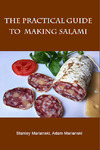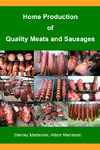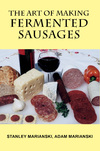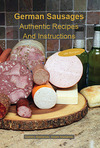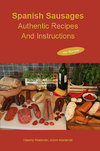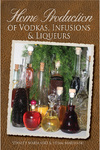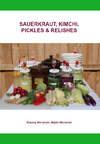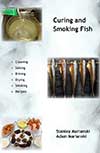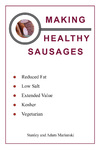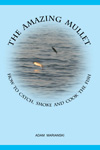Meats and Sausages
Low-Salt Sausages
It is a fact that a large percentage of the Western population develops high blood pressure in later years. Once it develops, there is no way back, and at best, we can only try to control it. We control it by suddenly paying attention to the amount of salt a particular food contains. We develop high blood pressure not by eating sausages but by consuming ready-to-eat products that we warm up at home on a stove or in a microwave. Just look at the amount of salt a canned soup, canned vegetable, or fish contains. It is scary. Salt is added in such a high amount to prevent the growth of bacteria. We have no control over it unless we make our chicken soup or other products ourselves. By cooking at home, we add only the amount of salt that is needed for good flavor, This amount will be well below what is added by commercial producers. The problem is that we lead such a hurried life that we have no time to cook, and fewer people even know how. The current average sodium consumption in the U.S. is 3,400 mg/day, compared to the recommended limit of 2,300 mg/day.
Contrary to popular belief, the sausages do not contain as much salt as we normally like to think. A typical range is from 1.5% to 2% salt in relation to the weight of a sausage mass. An average figure will be between 1.5% and 1.8%. In some sausages, such as liver sausages, head cheeses, and blood sausages, one can lower the salt content even further without affecting the flavor of the sausage. You can go as low as 1%, and the sausages will still be of acceptable quality. The only exceptions are slow-fermented dry sausages (salami type) or cold-smoked spreadable fermented sausages, which are not submitted to heat treatment. Those sausages need 3% salt to protect the meat from undesirable bacteria, and there is no room for compromise here.
When World War II ended in 1945, there was no refrigeration in damaged countries like Poland, Germany, Russia, and others. Sausages were produced with food preservation in mind, and they contained about 2.3% of salt. Those countries lay at a similar latitude to Quebec in Canada, which provides good conditions for keeping food at room temperature most of the year. Everybody had a storage unit in the common basement of a building or a designated pantry in the apartment. Those conditions, plus the right amount of salt, nitrate, and manufacturing procedures such as curing and smoking, allowed the creation of meat products with a very long shelf life. However, even those salt levels were below the alt percentages we find in processed foods nowadays.
We don’t need to go over 2% salt today as a refrigerator takes care of food preservation. For a person on a low-sodium diet, 1.5% salt is fine too. For people on a low sodium diet, the only way to reduce those amounts further is to investigate the possibility of partial substitution of common sodium chloride salt (NaCl) with potassium chloride salt (KCl), which is slightly bitter and requires more.
Potassium Chloride vs. Sodium Chloride
The salt we use for cooking is Sodium Chloride (NaCl), and sodium is what increases our blood pressure. Sea salt, which is made by evaporating seawater, includes traces of different minerals that were too heavy to evaporate. But it is still sodium chloride salt, which people on low-sodium diets try to avoid. Potassium chloride does not contain sodium and is used by commercial manufacturers to make low-sodium salts. It has a bitter metallic taste, so it is mixed in varying amounts with regular sodium chloride salt. No more than 30% of potassium chloride salt should be added; otherwise, there will be a noticeable difference in taste.
Salt substitutes vary in their composition, but their main ingredient is always potassium chloride. For example, the listed contents of the NuSalt are potassium chloride, cream of tartar, and natural flavors derived from yeast. Contains less than 20 mg of sodium per 100 grams. The contents of the NoSalt are potassium chloride, potassium bitartrate, adipic acid, mineral oil, fumaric acid, and silicon dioxide. A salt substitute does not taste exactly like sodium chloride, but it is similar enough and contains less or none of the sodium that some people are trying to avoid. /p>
You can reduce the amount of sodium in your diet by following these guidelines:
- Read labels carefully and choose foods that have less salt. All commercially prepared foods, such as fast food, canned vegetables, soups, commercially prepared meats, and other packaged convenience foods contain very large amounts of salt.
- Cook your meals.
- Use salt substitutes.
Choosing salt substitute
The number one step is to pick up a salt substitute that will be used and become familiar with it. Let’s assume that a sausage will contain 1% of salt, and that calls for adding 10 g of salt to 1 kg (1000 g) of meat. Mix 10 g of salt substitute (about 1½ teaspoon) with 1 kg of meat, make a tiny hamburger, cook it and see how you like it. Let your palate be the judge. Read the label carefully to see how much regular salt (sodium chloride) a particular salt substitute contains, and you will know exactly how much salt your sausage contains. There are different brands of salt substitutes and they contain varying amounts of sodium chloride.
Curing
Best quality smoked products incorporate meat that is cured with salt and sodium nitrite (Cure #1 in the USA or Peklosol in Europe). To cure 1 kg of meat, 150 parts per million of sodium nitrite are introduced, and only 2.4 g of Cure #1 is required (about 1/3 of the teaspoon). As Cure #1 contains 6.25% sodium nitrite and 93.75% sodium chloride, 2.25 g of salt will be introduced. This comes to 0.2% salt, which is of little concern for people on low-sodium diets.
People in countries where Peklosol is prevalent have more of a problem. Peklosol contains only 0.6% sodium nitrite and 99.4% salt. To cure 1 kg of meat, introducing 150 parts per million of sodium nitrite, 25 g of Peklosol (4 teaspoons) is required. This introduces 24.85 g of salt and comes to 2% salt, which is too much for people on low-sodium diets. They may opt for curing with 75 ppm of sodium nitrite (the minimum amount for any meaningful curing), which comes to 1% salt in the finished sausage, OR they can switch to American Cure #1 which contains a higher proportion of sodium nitrite.
Another solution is not to cure meat with sodium nitrite at all and smoke it at 180° F (82° C). This eliminates the danger of contracting botulism food poisoning but will not impart the pink color that is associated with smoked meats.
Some products are more suitable for salt substitution than others:
- Fresh sausages. These sausages are so simple to make that using salt substitution will bear little importance on the safety of the finished sausage. They are kept in a refrigerator and eaten within a few days.
- Liver and blood sausages. These products are usually made with less salt to begin with and salt substitute will work just fine.
- Head cheese and meat jellies can be made with little salt or even without it. In a head cheese meat binding is accomplished by the bonding properties of gelatin, not by protein extraction due to the action of salt.
- Emulsified sausages such as hot dogs, frankfurter or bologna require good emulsification which is dependent on protein extraction. Salt contributes largely to this process as many proteins are salt soluble, this means they mix with salt solutions. Using less salt will inhibit protein extraction and it will be harder to produce a good emulsified sausages. To make up for this, lean meat, which contains more protein is recommended. A sharp knife and a small grinder plate 1/8” (3 mm) will aid in protein extraction.
- Hot smoked sausages can be successfully made with salt substitutes.
- Fermented sausages and cold smoked products should not be made with salt substitutes.
Recipes
You should be able to modify any existing recipe or create your own. Keep in mind that increasing the amount of spices will make up for using less salt. Making low-sodium sausages requires less salt or using a combination of sodium chloride and potassium chloride salt. However, adding more than 50% potassium chloride will negatively contribute to the taste and flavor of the product.

